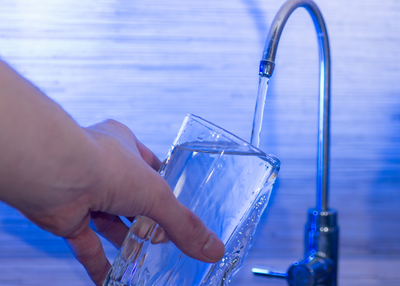By Brendan Elmore
While most people talk about chlorinated tap water, a growing number of municipalities are implementing an alternative disinfectant - chloramine – in place of chlorine. This article on chloramine vs. chlorine discusses the advantages and disadvantages of both disinfectants, why municipalities are switching to chloramine, and what this means from a water filtration standpoint.
Chlorine: The Original Method For Tap Water Disinfection
Chlorine was the original disinfectant used in US municipalities, with Jersey City being the first city to implement a chlorine-based system in 1908. Still today, chlorine remains the primary disinfectant in the majority of municipalities in the US, because of its effectiveness and low cost. While tap water disinfection using chlorine has a long track record, there are two major downsides to using chlorine as a disinfectant altogether.
- Chlorine is volatile and can escape from tap water as it travels through water mains, which can eliminate the “chlorine residual.” Without residual chlorine, water becomes more susceptible to microbial growth.
- Chlorine can react with naturally-occurring organic compounds, creating what are known as disinfection by-products (DBPs) which are associated with kidney and liver problems.
Chloramine: A 'New' Alternative to Chlorine
Chloramine is an alternative disinfectant that has gained popularity with a growing number of municipalities (including Washington, DC) because it directly addresses the two major problems with chlorine-based disinfection.
- Chloramine is less volatile than chlorine, so it stays in the water longer than chlorine, which ensures that all areas of the distribution network are properly disinfected.
- As the EPA began to learn about the toxicity of DBPs, they began searching for an alternative disinfectant for chlorine. Chloramine is less reactive with naturally-occurring organic matter, so it produces lesser amounts of DBPs.
Despite these advantages, chloramine isn’t without its own shortcomings. For example, when a municipality switches over to a chloramine-based system to comply with DBP regulations, the level of pipe corrosion inhibitor needs to be increased, because chloramine-treated water is more corrosive than chlorine-treated water. Washington, DC did not properly do this when they switched over to a chloramine-based disinfection system in the early 2000s, and the city underwent a 5-year lead contamination crisis where more than 42,000 children under the age of 2 were exposed to high levels of lead, putting them under great health risk.
Even when pipe corrosion is properly accounted for, chloramine must be removed from the water when it is being used for dialysis, aquariums, baking, and even craft brewing (maybe you didn't burn your mash after all!).
What Can I Do to Remove Chlorine & Chloramine From My Tap Water?
Removing chlorine and chloramine from water involve different methods.
Fortunately, chlorine is very easy to remove from tap water to improve the taste. For example, if you fill a water jug and leave it in your fridge uncapped, within a day or two, the chlorine will volatilize and go away.Common filtration pitchers, refrigerator pitchers, and under sink filtration systems are also good for removing chlorine from water and the bad taste associated with it.
Chloramine, on the other hand is much harder to filter, and most “big name” water filters are not designed to remove it. A special type of activated carbon, called catalytic carbon, is the best tool for removing chloramine from water. High-quality custom water filters that use catalytic carbon in their filter formulation also offer broad protection against other contaminants in drinking water.
If you have any questions about chlorine or chloramine, we encourage you to take advantage of Hydroviv’s “Help No Matter What” approach to technical support, even if you have no desire to purchase a Hydroviv system. This free service can be reached by emailing support@hydroviv.com, or by using the live chat window.
Other Great Articles That We Think You'll Enjoy:
5 Things You Need To Know About Chromium 6 In Drinking WaterWhy TDS Meters Don't Tell You Anything About Lead ContaminationLead Contamination In Pittsburgh Tap Water
Article Sources
https://www.scientificamerican.com/article/how-does-chlorine-added-t/
http://www.caslab.com/News/testing-for-trihalomethanes-in-your-water-tthm.html
http://www.chloramine.org/chloraminefacts.htm
https://www.washingtonpost.com/local/dcs-decade-old-problem-of-lead-in-water-gets-new-attention-during-flint-crisis/2016/03/17/79f8d476-ec64-11e5-b0fd-073d5930a7b7_story.html
Technical Memorandum No. MERL-2013-57 Effect of Chlorine vs. Chloramine Treatment Techniques on Materials Degradation in Reclamation Infrastructure





